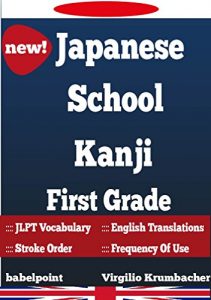This book contains the 80 Kyōiku kanji (education kanji) taught at primary school in Grade 1. The book is divided into 8 lessons. Each lesson contains 10 kanji. Every kanji is explained in 4 sections.
1. Kanji List:
This is the list of the 10 kanji that are taught in the lesson.
2. Kanji Image:
Every kanji is presented in a large handwriting font. The root of the kanji is coloured in blue. The rest is black. The kanji is labelled with numbers that show the direction and sequence in which the strokes must be written.
3. Kanji Glance Table:
Every kanji has a glance table with important details:
Onyomi: this is the Chinese reading. The onyomi reading is written in capital letters.
Kunyomi: this is the Japanese reading. The kunyomi reading is written in lowercase letters.
Grade: this is the grade/schoolyear in which the kanji is taught. So 1 stands for grade 1
JLPT: means Japanese Language Proficiency Test. The value here refers to the JLPT level in which this kanji is taught.
Frequency rank: shows the frequency rank number of the kanji. It is important to know that school kanji are not taught by frequency order. We offer you the frequency order for the most commonly used 2500 kanji. The first 500 kanji have the prefix A, the next 500 B etc.
Strokes: contains the total number of strokes.
Kanji Nº: The number outside of the parenthesis refers to the school order and the order in this book. The number in parenthesis refers to the total order. For example 1 (81) means: kanji Nº 1 from Grade 2. This kanji will be taught in the next book.
Translations: Here are the most important translations into English.
4. Examples:
In the example section you can find examples of words which are essential to pass the various levels of the JLPT. The frequency indication of every kanji is in parenthesis.
5. Revision:
At the end of every lesson you will find a revision section where you can see the glance table and the kanji on a single page. The size of the kanji is decreased. Similarly, at the end of the book you can find a general revision with all the kanji that are presented in the book.
1. Kanji List:
This is the list of the 10 kanji that are taught in the lesson.
2. Kanji Image:
Every kanji is presented in a large handwriting font. The root of the kanji is coloured in blue. The rest is black. The kanji is labelled with numbers that show the direction and sequence in which the strokes must be written.
3. Kanji Glance Table:
Every kanji has a glance table with important details:
Onyomi: this is the Chinese reading. The onyomi reading is written in capital letters.
Kunyomi: this is the Japanese reading. The kunyomi reading is written in lowercase letters.
Grade: this is the grade/schoolyear in which the kanji is taught. So 1 stands for grade 1
JLPT: means Japanese Language Proficiency Test. The value here refers to the JLPT level in which this kanji is taught.
Frequency rank: shows the frequency rank number of the kanji. It is important to know that school kanji are not taught by frequency order. We offer you the frequency order for the most commonly used 2500 kanji. The first 500 kanji have the prefix A, the next 500 B etc.
Strokes: contains the total number of strokes.
Kanji Nº: The number outside of the parenthesis refers to the school order and the order in this book. The number in parenthesis refers to the total order. For example 1 (81) means: kanji Nº 1 from Grade 2. This kanji will be taught in the next book.
Translations: Here are the most important translations into English.
4. Examples:
In the example section you can find examples of words which are essential to pass the various levels of the JLPT. The frequency indication of every kanji is in parenthesis.
5. Revision:
At the end of every lesson you will find a revision section where you can see the glance table and the kanji on a single page. The size of the kanji is decreased. Similarly, at the end of the book you can find a general revision with all the kanji that are presented in the book.






